13—
A Veritable Revolution:
The Global Economic Significance of the California Gold Rush
Gerald D. Nash
To many Californians the mention of January 24, 1848, conveys no special meaning, nor is that date widely commemorated in the state. Yet it has a special significance in the history of California, for on that day James Marshall, a moody carpenter from Missouri, discovered the first golden nuggets that resulted in the stampede known as the California Gold Rush. In the remoteness of Sutter's Mill, Marshall could scarcely imagine that his find would set off a succession of events that would have a far-ranging importance for California, the United States, and the world. The timing of the event was crucial also because it happened when the nation was just about to feel the growing impact of the Industrial Revolution—a revolution that in the next half-century would transform the United States from an agrarian society into an industrial giant. Within this broad context the Gold Rush helped to trigger momentous economic changes. In the language of economists, it served as a multiplier—an event that accelerated a chain of interrelated consequences, all of which accelerated economic growth. In both state and nation it spurred the creation of thousands of new businesses, banks, and financial institutions. It stimulated rapid agricultural expansion, quickened the volume of trade and commerce, and created demands for new forms of transportation. Since 1848, the Gold Rush has always had a romantic aura, of course. But it should not be forgotten that it was also a major chapter in California's economic development. As one historian has noted, "The American emphasis on the gold and silver rashes as adventures rather than economic industrialization stood in embarrassing contrast to the more realistic accounts of Mexican, South African, and Australian mining."[1]
The Gold Rush spawned a wide range of entrepreneurial activities and led thousands of individuals in California and elsewhere to embark on new business ventures, in manufacturing as well as in service industries. Food, clothing, hardware, mining
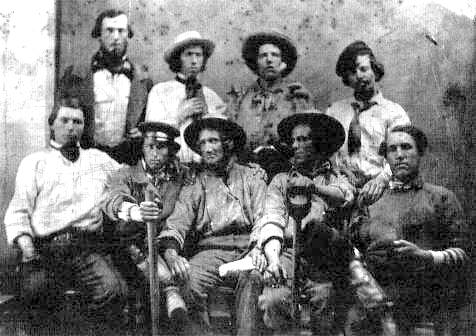
California Argonauts—some dressed in the rough clothing of the mines, others wearing
boiled, white shirts and ties—stare confidently at us across a century and a half of time.
Aware of the historical moment of the great westward movement, the grand adventure
of gathering the golden harvest, the Forty-niners preserved their experiences in countless
journals and letters home. Though their sagas of long journeys overland and around the
Horn, their tales of hard labor and struggle in the mines, are the stuff of legend, of even
greater significance are the economic, cultural, and social consequences of the Gold Rush
. California Historical Society, FN-25814 .
supplies, all kinds of luxuries, and steamboats for river traffic—these were only a few of the items in great demand, and ambitious men and women scurried to provide them. When mining machinery came to be in short supply, newcomers in less than a decade created an iron industry in northern California. There they manufactured stamp mills, steam engines, and nozzles for hydraulic operations. Already by 1861 more than a thousand workers in San Francisco toiled in the manufacture of mining equipment. The city boasted thirteen iron foundries and thirty machine shops. Twenty-three other foundries operated in other parts of the state. Mining also required many auxiliary operations in need of explosives, and as early as 1855 newcomers to California had built two powder works, reducing the need for imports from the East.[2]
Gold mining stimulated other industries as well. It created an enormous demand
for lumber, not only for housing, but for mine shafts and tunnels. Within a decade Mendocino and Humboldt counties were producing thirty-five million board-feet annually.[3] California also quickly established itself as one of the most important flour-milling states in the Union. In 1848, California had no commercial flour mills to speak of; but by 1860 two hundred flour mills were operating, supplying not only local demand, but exporting large quantities to the entire Rocky Mountain region, and also to China, Japan, Great Britain, and parts of Europe.[4]
The decade after the Gold Rush was an opportune time for wagon and carriage makers. Among the ablest was a young newcomer from the Middle West who made a name for himself very quickly in Placerville. After making his fortune in pioneer California, John Studebaker eventually returned to Indiana. At the turn of the century he became one of the most important automobile manufacturers in the nation. with capital he had amassed during California's pioneer era.[5]
The state's rapid population increase generated a seemingly unlimited demand for clothing, which local enterprisers quickly filled. Within a decade the Mission Woolen Mills became one of the largest in the West. Levi Strauss, one of the most imaginative clothing manufacturers in San Francisco, had great success when he developed blue jeans, a garment particularly well suited for miners and workmen in the 1850s—and generations of other people in succeeding years. Since there was a large number of cattle in California, development of a leather industry in a very short time was eminently feasible. By 1860 the fabrication of boots, harnesses, saddles, and belts for machines was well established.[6]
Retail trade flourished under the conditions stimulated by the Gold Rush. Creation of instant markets with tens of thousands of eager consumers fostered a wide range of wholesale and retail establishments catering to miners. John Bidwell, Alonzo Delano, and Charles M. Weber were some of the merchants who quickly became highly respected citizens and powerful political leaders in the California of the 1850s. Coilis P. Huntington, later a railroad tycoon, laid the basis for his fortune in the wholesale trade in Sacramento. He and his partner, Mark Hopkins, began by building the largest wholesale and retail hardware store there and one of the biggest in the entire West. In later years these men branched out to organize the Central Pacific Railroad, which they justly viewed as a key to further expansion of the economy.[7]
Without a doubt, the Gold Rush was the major stimulant of California agriculture in the 1850s. Certainly farming was hardly less significant than gold mining in laying the foundations of California's new economy. Often, when individuals did not succeed in mining they turned to agriculture. Thousands became small farmers, viticulturists, fruit growers, and dairy farmers. Others became sheep and cattle raisers who found lucrative markets not only in California, but up and down the Pacific Coast. The Gold Rush was not merely a local economic event. California's products found their way to
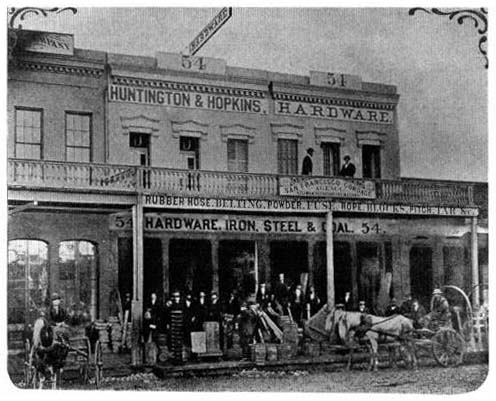
The Huntington & Hopkins Hardware Store on K Street in Sacramento. It was here on a winter's
evening in 1861 that the civil engineer Theodore Judah persuaded four shopkeepers who had made
their "piles" retailing goods to miners to invest in his dream of a transcontinental railroad. The
building of the Central Pacific created enormous fortunes for the Big Four—as Huntington,
Hopkins, Stanford, and Crocker came to be called— and played a powerful role in the course
of California history. Courtesy Mariners' Museum, Newport News, Va .
the Pacific Rim as well. The Gold Rush coincided with the opening of Japan to trade by Commodore Matthew Perry in 1853, and California benefited more from these contacts than any other American state. Commercial relations with China expanded also as a result of aggressive efforts by San Francisco merchants. They found that California farm products enjoyed considerable success in Asia, as did beef and mutton. By 1860, Henry Miller, a German immigrant, had become the largest rancher in the state, with more than three million head of cattle. And the one million sheep reported in that year outnumbered the state's inhabitants.[8]
In just a few years after the first gold discoveries California became one of the most productive grain producers in the nation. Stimulated by the population surge prompted by the Gold Rush, thousands of newcomers became wheat farmers, es-
pecially in the San Joaquin and Sacramento valleys, where the soil was well suited for grain culture. The Gold Rush occurred at a most propitious moment for California wheat culture. The ships that brought the gold seekers to the Pacific Coast often sailed back to Atlantic ports without substantial cargo. With the development of wheat farming, these empty vessels were able to take on bulky grain shipments, giving Californians access to East Coast, British, and continental European markets.[9] Moreover, the Gold Rush had a dynamic impact on the state's agriculture because it coincided with revolutionary technological advances in the 1850s. Cyrus McCormick had just developed his reaper, a machine that greatly reduced the need for hand labor and did much to increase productivity. Since California during the Gold Rush had a chronic labor shortage, such a labor-saving device was particularly important in boosting production. Moreover, the vast open stretches of virgin land in the San Joaquin Valley were extremely well suited to the development of mechanized farming. In some ways, McCormick can be considered as one of the fathers of mechanized agriculture in California during the gold-rush era and even in succeeding years. In 1850, relying on crude, labor-intensive methods, California farmers produced just seventeen thousand bushels of wheat; ten years later their total was sixteen million bushels.[10] Technology and commercial conditions combined to make wheat no less profitable than gold.
The population drawn by the Gold Rush created exciting new markets for California farmers. Climate and soil aided them in quickly developing a wide range of crops. In the 1850s Californians grew apples and oranges, peaches and plums, cherries and figs, among a wide range of new varieties. In only a few years California was well on the way to becoming the fruit basket of the nation. At the same time, new farmers were producing impressive quantities of vegetables, from corn to carrots, squash, and potatoes. Since the growing season was much longer than in the East, the output of California's farmers was prodigious, and very profitable.
Along with fruits and vegetables, some of the new immigrants of the gold-rush generation also laid the foundations for a successful wine industry. Miners may have liked their whiskey, but quite a few also developed a taste for wine. Agoston Haraszthy, an enterprising Hungarian immigrant, quickly grasped the potential opportunities and planted dozens of varieties imported from Europe, as well as new strains. Deservedly, he became known as the father of the California wine industry, since he not only grew a variety of grapes, but built markets both in the state and around the world.[11]
The growth of mining, business, and agriculture stimulated the establishment of banks and financial institutions. Such expansion was slow in the 1850s only because the California Constitution of 1849 prohibited the creation of commercial banks. The prohibition received widespread support because members of the constitutional convention clearly remembered the Panic of 1837, which, rightly or wrongly, they at-
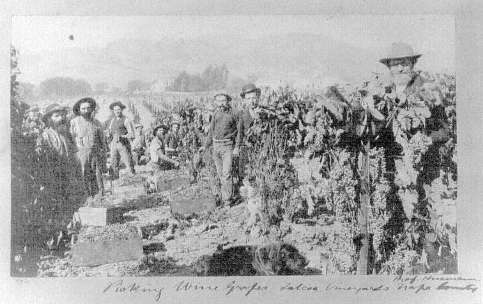
Workers harvest wine grapes at Talcoa Vineyards, Napa County, under the supervision
of Professor George Husmann, far right . Among the most scholarly viticulturists of his
day, Husmann built on the knowledge established by Agoston Haraszthy and others, and
in 1888 he published the handbook Grape Culture and Wine Making in California , which
helped to advance the industry. California Historical Society, FN-21172 .
tributed to the lax issuance of unbacked paper money by banks. Before 1849 California had had no banks, but the Gold Rush created new needs. Miners required places of safekeeping for their gold, and individuals desired banks to transfer money. Furthermore, the increasing number of business establishments involved in trade and commerce looked for banks to execute their transactions. Initially, eastern banks established branches to provide such services, Wells Fargo among the most prominent. By the late 1850s Californians were also providing capital to develop mining throughout the West, including Oregon, Idaho, Arizona, and Colorado, but most importantly for the rich silver mines on the Comstock Lode in Nevada.[12] Californians organized hundreds of stock companies to finance such ventures. The lure of greater profits led one of the most powerful financiers, Sam Brannan, to lobby the California legislature for the removal of the constitutional prohibitions on commercial banking. Finally, in 1862, the lawmakers authorized the establishment of state-chartered savings banks; two years later they allowed commercial banking. As the Civil War further fueled an economic boom, scores of new bankers appeared. One of the most important was William Ralston, who in 1864 organized the Bank of California. Along with William Sharon, his manager in Nevada, Ralston became
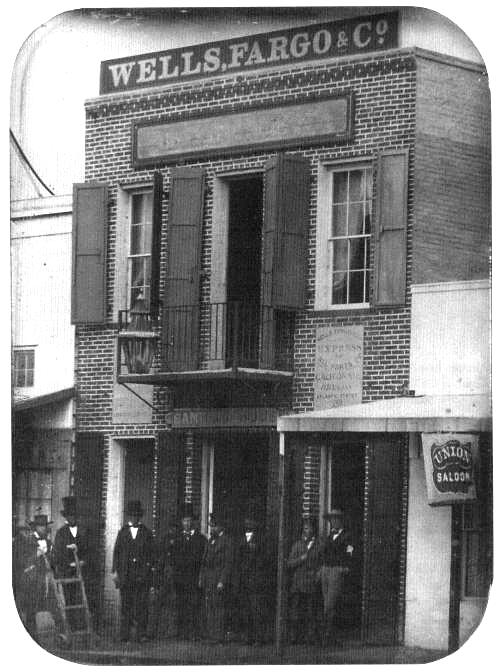
Officers of Wells, Fargo & Co. stand before the firm's first office, at 124 Montgomery
Street, San Francisco, which in July 1852 opened its doors for business. Although the
pioneer banking house has evolved enormously since it instituted an express line of
coaches from San Francisco to Sacramento and Marysville, it clings to the imagery of
its early days and maintains its corporate headquarters on virtually the site of this
daguerreotype. Courtesy Wells Fargo Bank .
the dominant presence on the Comstock Lode. The bank financed not only the major mining ventures there, but provided capital for new railroads, steamship lines, water companies, hotels, and a wide range of service industries, even including cemeteries.[13] Few examples better illustrated the multiplier effect of the Gold Rush than the California banks that spawned a large number of new enterprises that built an intricate economic structure in the state.
In that structure, transportation played a dominant role, and the Gold Rush did much to underscore its importance. No other event so dramatized California's geographical isolation. From the beginning, the Argonauts scrambling to reach the gold fields encountered arduous difficulties. Whether they came by ship around the Horn, or sailed to Central America and then made their way across the disease-rid-den Isthmus of Panama, or whether they came by land across the prairies in covered wagons, the journey was an ordeal. Those who survived the trek were especially eager to link California more closely to the rest of the nation, as were business people in the East. In the minds of most Californians, and many Americans, transportation held the key to a blossoming of the state's economy.[14]
Between 1848 and 1862 Californians experimented with various ways to end their isolation. They tried wagon trains over the Sierra and coastal steamers along the Pacific Coast, and petitioned Congress to appropriate moneys for a transcontinental highway from Missouri to the West Coast. Seventy-five thousand people signed this petition, fully one-half of the state's population. Yielding to such pressure, Congress in 1856 appropriated $500,000 for a road to stretch from Missouri to Carson City, Nevada. Work was completed in September 1858 and almost immediately John Butterfield secured a federal contract for carrying the mails. He also promised passengers that he would deliver them to western destinations in twenty-five days or less. But neither the stage line, nor the Pony Express, nor the transcontinental telegraph lessened the desire for a railroad in the minds of most Americans.[15]
Support for the building of a transcontinental railroad gathered additional momentum with the outbreak of the Civil War, which underscored California's isolation. In California the project was most ardently promoted by Theodore Judah, a young engineer who had come from Connecticut in 1854 to work on the Sacramento Valley Railroad. Unable to raise the capital needed for the enterprise in San Francisco, he made the rounds of wealthy individuals in Sacramento. In 1860 he approached Collis P. Huntington and his hardware store partner Mark Hopkins, as well as other successful merchants such as Leland Stanford and Charles Crocker. Each agreed to provide about $20,000 for experimental surveys of routes across the Sierra. In June of 1861 the five men incorporated the Central Pacific Railroad. Such a vast undertaking could not be accomplished solely by private enterprise, however, and a few months later Judah and Huntington journeyed to Washington, D.C., to lobby for federal aid. Within a year, the wartime Congress, in part responding to Ju-
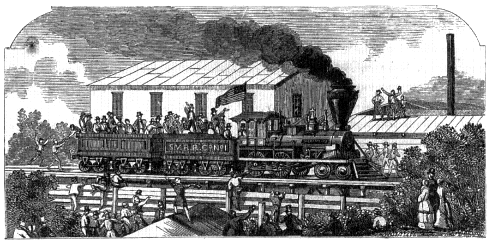
A jubilant crowd hurrahs the passage of the Sacramento Valley Railroad's locomotive in a
spirited wood engraving titled "First Railroad Ride in California," which appeared in the
Sacramento Pictorial Union in 1856. Completed in February of that year, the road ran
from Sacramento to Folsom, a grand distance of twenty-two miles, and reduced travel
between the great river port and the mines by a full day. The era of railroading had dawned
in California. California Historical Society, FN-10954 .
dab and Huntington's political pressure, enacted the Pacific Railroad Act of 1862, which granted lands and loans to the company and the Union Pacific Railroad so that the work could begin. Although the transcontinental railway was not completed until 1869, after 1862 the end of California's geographical isolation was in sight.[16] The Gold Rush had hastened removal of yet another obstacle to California's dramatic economic growth.
The population surge prompted by the gold discoveries also stimulated the building of a canal across the Isthmus of Panama. Between 1848 and 1869 tens of thousands of people headed for California across that once-remote area. The sudden influx brought new economic opportunities for some of the regions inhabitants. It also fostered a considerable increase in prices for many goods, benefiting some and injuring others. This influx of tourists prompted a group of American investors to build the Panama Railroad across the isthmus. Although it was only 47.5 miles long, the difficult terrain slowed construction, and it was not until 1855 that the line became operational.[17] But the influence of the Gold Rush on transportation development did not end with the Panama Railroad. The project fixed the dream of a transisthmian canal firmly in the minds of many Americans of that generation. The dream persisted so vigorously that the building of the Panama Canal between 1880 and 1914 was in a very real sense a consequence of the California Gold Rush of 1849.[18]
From the very beginning, the Gold Rush had worldwide ramifications. It affected the economies not only of the United States, but of Central and South America, of Europe, and of the Far East. In the Western Hemisphere, Chile proved a prime example of the influence of events in California on world trade. Before 1848, Chilean farmers had found few market outlets for their products. But the Gold Rush quickly afforded them new opportunities as California emerged as a major market. Chileans shipped their wheat and flour, all kinds of fruits, and large quantities of beef at very profitable prices. Even Mexico, which had just emerged from a humiliating war with its northern neighbor, gained some trading advantages from the gold discoveries. In 1849 more than nine thousand Americans passed through northern Mexico on their way to California, purchasing supplies and stimulating an increase in price levels. At the same time, thousands of Mexicans also rushed north to the California gold mines. But the discrimination they encountered there was increasingly discouraging, and by 1854 the flow of Mexican immigrants lessened.[19]
The influence of the Gold Rush on European economies varied. Among those that were profoundly touched was Norway, whose economy was heavily dependent on shipping and trade and commerce. Norwegian merchants and shipowners looked on the newly emerging economic opportunities on the Pacific Coast with a lively fascination. Already in the 1850s the Norwegians were actively discussing the potentials of a canal across the isthmus. At the same time, Norwegian iron manufacturers were hopefully watching California as a potential big market for rails and railroad equipment, a market they expected to develop quickly. So intense was Norwegian interest in the California Gold Rush that many major newspapers prominently featured letters from Scandinavian miners in their pages.[20]
Elsewhere on the European continent, the Gold Rush was also significant. For thousands of young Frenchmen undergoing the throes of the Revolutions of 1848, California beckoned as a source of new job and investment opportunities. They organized at least eighty-three companies in 1850, not only for gold mining, but also for investments in real estate, farming, and service industries. After 1852, French interest ebbed as Louis Napoleon established political stability in France.[21] In Germany the Gold Rush also attracted considerable interest. Of the one million Germans who came to the United States during the 1850s, at least 30,000 settled in California, many as farmers or in the grocery business. By 1860 at least 14 percent of California's population was German. This heavy emigration caused labor shortages in the German states during the 1850s, although it eased population pressures in succeeding years. The Gold Rush also affected the Sardinian and Italian states, where increased price levels brought about by gold production created new capital available for building of railroads and telegraph lines.[22]
Great Britain, perhaps, was most directly touched by the Gold Rush. Of the 500,000 British immigrants who came to the United States in the 1850s, at least
50,000 many of them skilled Cornish, Welsh, and Irish miners, settled in California. But the economic effects on the mother country were more varied than those experienced elsewhere in Europe. As a manufacturing nation, Great Britain depended on imports of food, and needed specie to pay those nations that could not afford to buy its manufactured products. Before 1848 an increasing shortage of gold had hampered British trade. But the new gold coming from the California mines relieved the specie shortage. As annual production of the metal reached $131 million annually between 1850 and 1855, the amount of gold in the world's money markets increased. That raised prices everywhere. And as the cost of goods also rose in California, the demand for British manufactured goods increased as well. By 1856, British exports to California exceeded $2 million annually. As California gold contributed significantly to the worldwide increase in prices, the British economy profited enormously with booming exports. At the same time this increased demand for British goods benefited many workers, whose wages rose faster than prices.[23]
Nations in the Pacific area were also sensitive to the California gold discoveries. The Gold Rush created a critical labor shortage in Hawaii, where a sizable number of sugar plantation workers migrated to the California gold fields. That also brought a marked increase in the prices of consumer goods, especially foodstuffs. In part this was also due to the great increase of agricultural exports to California, which offered very profitable new markets. Hawaiian trade with the more distant Atlantic seaboard declined, as the increasingly multifaceted contact with the Pacific Coast increased. The exodus of workers from sugar plantations between 1848 and 1853 was so great that employers began to import Chinese immigrants to fill the gap, thereby forever altering the ethno-cultural structure of the islands.[24]
The Gold Rush left ripples in China as well. Between 1848 and 1852, thirty-five thousand Chinese left for California; they constituted at least 10 percent of the population during the 1850s. California gold discoveries coincided with the Taiping Rebellion in China, a violent civil war that led to much plunder and famine, and created thousands of refugees. Eager to emigrate, many peasants from Kwangtung (Guangdong) province heard about California from traders there. Once in the United States, in addition to engaging in mining, they performed a variety of services, including laundry, food production and preparation, and construction. In addition, they were quietly involved in a variety of businesses. These included the importation of ready-made clothing from China, and even prefabricated houses. From the beginning of statehood, Californians initiated commercial contacts with their Chinese neighbors, even if they did not treat them as equals during the nineteenth century.[25]
The Gold Rush and the resulting increase of gold in circulation contributed to higher price levels throughout the world. In the decade before 1848, prices had declined in developed nations. The tight money policies of the Bank of England and
also the Bank of France had contributed to this decline and led to a shortage of specie. California's gold production changed that situation and precipitated the rise in wholesale and commodity prices. The effects in the United States were also notable. No longer did the nation have to depend mainly on capital brought by immigrants, or produced by imports. Instead, the coinage of gold increased the amount of money in circulation and produced a favorable trade balance for the United States.[26]
Indeed, throughout the second half of the nineteenth century, rising and falling world prices were closely related to gold production in California, and also in South Africa and Australia, where the California experience gave an impetus to the search for new mines. Between 1848 and 1870 increasing gold production raised price levels, but as the output slackened thereafter, the trend was reversed. Prices rose again from 1890 to 1896, boosted by new gold discoveries in Alaska and South Africa. Great Britain profited most from the increase of gold stocks because both the United States and South Africa exported their bullion to buy British goods. As E. Victor Morgan, a prominent British economist, noted in the twentieth century, "The most important single factor in the monetary history of the nineteenth century is the great increase in gold output, following the discovery of the mines of California and Australia."[27]
The Gold Rush had an important effect on the investment policies of European nations, particularly Great Britain. In the first decade after the discovery of gold, British stock companies invested at least $10 million in mining companies in California—most of which were not very successful. That experience led to a lull until 1870, when British investors took another fling in California mines. Between 1870 and 1873, twenty-seven companies poured at least £ 4 million into mining operations in the state, and more than twice as much in the Comstock Lode in Nevada. High hopes were disappointed, but the experience did much to familiarize British capitalists with California. Hope springs eternal, and between 1873 and the end of the century, British investors broadened their interests. Some, like the California Redwood Company, sent their monies to purchase forests in northern California. Others, like the California Orange and Vineyard Company, entered the southern part of the state and contributed to the economic boom of the late 1880s there. Others bought land and established ranches, as in Duarte. The Glasgow California Land Company reclaimed swamp lands in the San Joaquin Delta. Many of these ventures failed; one scholar estimated losses between 1880 and 1893 to be as high as £150,000. But the infusion of so much foreign capital did much to stimulate California's economy. It facilitated rapid expansion and certainly accelerated the building of railroads.[28] And of course the large volume of gold exports from California contributed mightily to create a favorable trade balance for the United States. Between 1850 and 1900 California's gold production constituted fully 59 percent of total U.S. gold production, totaling about $1.4 billion (or at least $25 billion in 1990 dollars).[29]
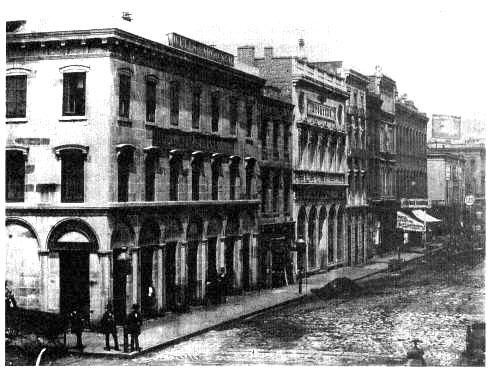
The solid stone and brick edifices lining Montgomery Street in the mid-1850s testify to the
transforming powers of gold. Where but a half-dozen or so years earlier a scattering village
of adobes and modest frame buildings had fronted Yerba Buena Cove, now stood a substantial
cosmopolitan city of hotels, shops, theaters, and banking houses. The cost of John Parrott's
elegant Granite Block, foreground, built in 1852 of stone quarried in China, possibly exceeded
the entire value of the frontier settlement that had earlier been galvanized by the cry "Gold!
Gold! Gold on the American River!" Courtesy Bancroft Library .
In many ways, the California Gold Rush precipitated a veritable economic revolution in the state, the nation, and the world. Production of precious metals affected price levels, labor, wages, capital investment, the expansion of business, finance, agriculture, service industries, and transportation. True, the California experience was not entirely unique. Precious metals had influenced the course of civilizations for thousands of years before 1848. When Emile Le Vasseur, the great French economist, in 1858 traced the historical relationship between the value of gold and the value of commodities, he identified fourteen major revolutions in world history, of which the California Gold Rush was the last in his lifetime.[30] Many of his views were shared by his contemporary, Karl Marx, who just one year later declared that his observations on capitalism were made in direct response to the gold discoveries in California. As Marx wrote in 1859, "The enormous material on the history of polit-
ical economy which is accumulated in the British Museum; the favourable view which London offers for the observation of bourgeois society; finally, the new stage of development upon which the latter seems to have entered with the discovery of gold in California and Australia led me to the decision to resume my studies from the very beginning and work up critically the new material." Those studies were soon to culminate in Das Kapital , a revolutionary book stimulated by the gold discoveries of the 1850s.[31]
The passage of time did not dim assessments of contemporaries as to the revolutionary economic impact of the California Gold Rush. The eminent British economist John Maynard Keynes wrote in 1930 that he viewed the rise and fall of civilizations in relation to precious metals. He surmised, for example, that Sumerian civilization could be explained by the gold of Arabia, the greatness of Athens by the gold of Laurium, and the stagnation of western Europe during the Middle Ages by the scarcity of precious metals. Historians agreed. Fernand Braudel, the French student of world civilizations, exclaimed that "the chapters of world history . . . follow the rhythms imposed by the legendary metals."[32]
In the final analysis, it might be said that the economic significance of the Gold Rush can also be understood in a psychological and philosophical context. As the French philosopher Michel Foucault once wrote, "the signs of exchange, because they satisfy desire, are sustained by the dark, dangerous and accursed glitter of metal. An unequivocal glitter, for it reproduces in the depths of the earth that other glitter that sings at the far end of the night; it resides there like an inverted promise of happiness, and because metal resembles the stars, the knowledge of all these perilous treasures is at the same time knowledge of the world."[33] Thus, the economic impact of the Gold Rush is rooted as much in emotions as in rational behavior. It touched a deep-seated nerve in the human psyche. Consequently, it had a profound influence not only on contemporaries, but on later generations, and is bound to exercise a continuing fascination in the future.